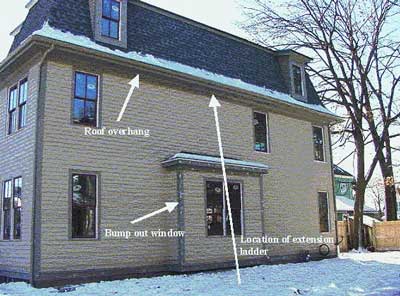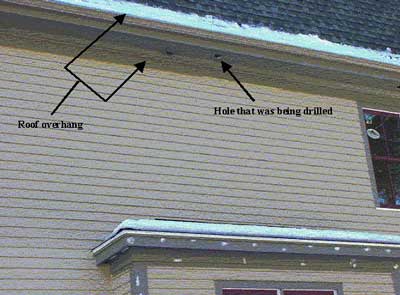
Case: 02-MA-042-01
Release Date: October 8, 2004
A Portuguese Speaking Laborer Working for a Korean Speaking Employer is Fatally Injured After Falling From an Extension Ladder - Massachusetts
SUMMARY
On December 19, 2002, a 41-year-old male laborer, who spoke Portuguese as a first language, was fatally injured when he fell from a 30-foot aluminum extension ladder. The victim was standing on the extension ladder drilling a vent hole in a roof overhang for a gas clothes dryer when he lost his balance and fell approximately 20 feet to the ground below. The only other company employee onsite was a co-worker, who spoke Korean as a first language, who was holding the base of the ladder for the victim at the time of the incident. A call was placed for emergency assistance and personnel from the police department responded to the scene within minutes. The victim was transported to a local hospital where he was pronounced dead. The Massachusetts FACE Program concluded that to prevent similar occurrences in the future, employers should:
In addition, general contractors should:
INTRODUCTION
On December 20, 2002, the Massachusetts FACE Program was alerted by the local media, that on December 19, 2002, a Portuguese worker died after falling from an extension ladder while drilling a hole for a vent. An investigation was immediately initiated. When the Massachusetts FACE Program called the employer to schedule the site visit, the employer's office manager stated that the victim was not an employee, the company employee on site at the same time as the victim spoke Korean, and that the company was minority owned. On January 16, 2003, the Massachusetts FACE Program Director and an investigator, who spoke Korean and English, traveled to the company's office location where the incident was discussed with the company owner, office manager and the co-worker who had been onsite at the time of the incident. The police report, death certificate, corporate information, OSHA fatality and catastrophe report and photographs of the incident location were reviewed during the course of the investigation.
The company was an appliance parts distributor that had been purchased in 1985 by the current owner. Since 1985, the company has evolved into an installation and repair service for plumbing, heating, ventilation and air conditioning for both residential and commercial structures. Company-wide, there were approximately 11 employees, including the victim who the company claimed was not an employee. Seven of these employees, including the victim, worked as field technicians. On the day of the incident, the victim and one other field technician were the only two company employees onsite, although there were other subcontractors onsite. The company's office manager was the designated individual in charge of safety and the company had a safety program. In addition, the company reported that they held monthly safety and health meetings at the office.
The victim's country of origin was Brazil; his prior employment in the United States was as a dishwasher for a local restaurant. Training had not been provided for the victim, although the company stated that they provide safety and health training for employees. Employees had no union representation at the incident company.
INVESTIGATION
During the site visit, the company owner and office manager reported that they had met the victim while at a previous project at a local restaurant. The victim was introduced to the company owner and office manager through another person who had asked about possible employment for the victim. It was reported that a few weeks later, the victim arrived at the incident company's office to follow-up on a possible job. The victim was given a job application to fill out, and according to the company owner, no job was offered at this time. The following day the victim showed up at the company's office a little before 8:00 a.m. and ran into one of the company's employees. The victim, who spoke Portuguese as a first language and this company employee, who spoke Korean as a first language, went off to the incident work site together. Both employees had limited English proficiency. The office manager reported that this employee had seen the victim at the previous job site (the local restaurant) and at the company office the previous day and thought that the victim was a new hire.
The work site that the victim and the Korean speaking employee went to was a residential construction site. The project consisted of a new building and an addition to an older house that was being split into townhouses. The structures had mansard style roofs with overhangs at the bottom of the third story (Figure 1). The roof overhang protruded past the side of the building approximately two feet (Figure 2).
The incident company was a subcontractor that had taken over for another subcontractor who had left the project. This was the company's third week on the project, although the work had not been continuous. The incident company was contracted to perform finish type plumbing work, such as installing sinks, faucets, and toilets. The incident company was told that the previous subcontractor had completed all of the rough plumbing.
The day of the incident had been the victim's third full day of work at this construction site, although the company reported that they had no knowledge that the victim was onsite working. The victim and the co-worker had been performing indoor tasks the entire day. One of these indoor tasks was preparing to install a gas drier on the second floor of one of the condominiums. During this task, they noticed that the air vent for the gas drier had not been roughed in.
The victim and the co-worker located the area on the exterior of the building where the vent hole needed to be drilled. At approximately 4:00 p.m., the victim and the co-worker setup a 30-foot aluminum extension ladder to complete this task. The ground where the extension ladder was positioned consisted of dirt with frozen ruts and mud. The ladder was set up so it extended over a single story bump out window with the top of the ladder below the roof overhang. The bump out window protruded from the main structure approximately two feet and was located directly below where the victim had to drill the hole (Figures 1 and 2).
The location for the air vent was on the underside of the mansard style roof overhang (Figure 2). The victim, using an electric drill, started to drill in a vertical direction up and over his head. He had been performing the drilling task for approximately 10 seconds when he lost his balance and fell from the ladder. The co-worker, who was holding the base of the ladder at the time of the incident, reported that the victim struck the roof of the single story bump out window while falling and landed on the ground below.
A call was placed for emergency assistance and the local police responded to the incident site within minutes. The victim was transported to a local hospital where he was pronounced dead.
Despite the fact that the victim and the co-worker did not speak the same language, the co-worker mentioned that he thought the victim was good at understanding his directions for the tasks to be performed. In addition, the company office manager reported that OSHA had inspected the ladder and drill after the incident. No problems were found with the drill, but the ladder was found to have a bent bottom rung and OSHA asked the company to discard the ladder.
CAUSE OF DEATH
The medical examiner listed the cause of death as blunt force head trauma.
RECOMMENDATIONS/DISCUSSION
Recommendation #1: Employers should provide supervision for all employees, which should include but not be limited to, regular communication between employers and employees about safe work conditions.
Discussion: In this case, the company owner and office manager claimed that the victim was not an employee, but that a company employee and the victim met at the company office and went to the work site together where the company employee assigned the victim tasks to complete. The company owner stated that both he and the office manager travel to work sites to monitor the progress of projects. Although the incident occurred on the victim's third full day onsite, the company owner reported that both he and the office manager did not have knowledge that the victim had been on site.
Employers should provide supervision and ensure that all employees have safe work conditions. This task becomes more challenging for construction projects because the work sites are constantly changing. Supervision should, at a minimum, consist of a combination of routine site visits, onsite toolbox talks, telephone conversations, and morning office meetings with employees to introduce new hires, discuss any concerns and progression of the project.
Recommendation #2: Employers should ensure that employees are provided
with safety training, in languages(s) and literacy levels(s) that all workers
understand. This training should include the recognition of hazards and use
of appropriate equipment to safely complete tasks.
Discussion: Overcoming language and literacy barriers is crucial to providing a safe work environment for a multilingual workforce. Interpreters should be available during employee's training and to explain any daily unexpected changes in tasks and the work environment.
The task being performed when the incident occurred required the victim to access the exterior of the residential structure at the top of the second story (approximately 20 feet high). The victim was using a portable 30-foot aluminum extension ladder to drill a hole into the underside of the roof overhang above him. At the time of the incident, the victim was overreaching directly above and slightly behind him while performing this task. This overreaching most likely was what caused him to lose his balance and fall off the ladder.
Employers should provide training to employees about the recognition and avoidance of unsafe conditions, and the need to control or eliminate these unsafe conditions. Training should include, but not be limited to, when scaffolding should be used instead of ladders to complete tasks, not to overreach when using ladders and scaffolding, always maintaining three-point contact with ladders during use, and never use ladders as work platforms. Training would have provided the victim with the knowledge to make an educated decision that using an elevating work platform (man lift) and not a ladder would have been safer to use to complete this task. An elevating work platform would have provided the victim with the space needed to take a step back away from the structure and safely complete the task.
Recommendation #3: General contractors should implement procedures to
provide health and safety information to and keep track of all subcontractors
on their projects.
Discussion: The general contractor's (host employer) responsibilities include, but are not limited to, providing information to all subcontractors on the work site about possible hazards and their controls, safety and health issues, and emergency procedures. The general contractor should have established procedures to create a clear line of communication with subcontractors. This communication should be established and maintained throughout the project, which will help the general contractor disseminate information and keep track of all the sub contractors on the project.
 |
|
Figure 1 - Incident Location |
 |
Figure 2 - Roof overhang |
To contact Massachusetts State FACE program personnel regarding State-based FACE reports, please use information listed on the Contact Sheet on the NIOSH FACE web site Please contact In-house FACE program personnel regarding In-house FACE reports and to gain assistance when State-FACE program personnel cannot be reached.